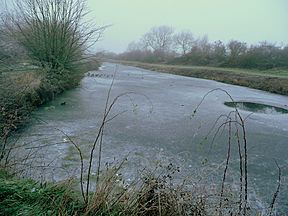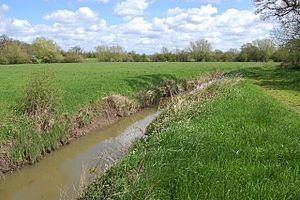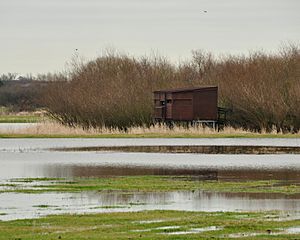Coombe Hill Canal facts for kids
Quick facts for kids Coombe Hill Canal |
|
|---|---|

The frozen canal from the terminal wharf
|
|
| Specifications | |
| Locks | 1 |
| Status | unnavigable |
| History | |
| Date of act | 1792 |
| Date completed | 1796 |
| Date closed | 1876 |
| Geography | |
| Start point | Coombe Hill wharf |
| End point | Wainlode Hill |
| Connects to | River Severn |
The Coombe Hill Canal is a historic waterway in Gloucestershire, South West England. It stretches about 4.4 kilometers (2.75 miles) from Coombe Hill to the River Severn. The canal opened in 1796 and was used for 80 years. It closed in 1876 after its only lock was damaged by floods.
Today, the Coombe Hill Canal area is a special nature reserve. The Gloucestershire Wildlife Trust bought the canal area in 1985. They also bought nearby wet meadows in 1999. These meadows are located between Gloucester and Tewkesbury. The canal and meadows often flood in winter, which attracts many wild birds.
Contents
History of Coombe Hill Canal
The idea for the Coombe Hill Canal was approved in 1792. It was likely finished and open for use by 1796. Building the canal cost about £5,000. Once built, it could carry large barges weighing 60 to 70 tons.
The canal was planned to help move goods to Cheltenham. However, there was a gap of almost five miles between the canal and the town. This made the canal less useful than people had hoped.
Over the years, different groups leased the canal. In 1810, three men leased it for £400 a year. Later, in 1822, a group from the Worcester and Birmingham Canal took over the lease. They renewed their lease in 1829 for 21 more years, paying £500 annually.
In 1844, they offered to buy the canal but later changed their minds. The Staffordshire and Worcestershire Canal then leased it in 1849. They struggled to make money from the canal. When they gave up the lease in 1867, the amount of cargo carried dropped a lot.
The Coombe Hill Canal company tried to run the canal themselves for a few years. They eventually sold it for £520 in 1871. The canal was resold for £1,000 in 1873. However, it was abandoned in 1876. The new owners could not afford to fix flood damage to the lock that connected the canal to the River Severn.
Why Coombe Hill Canal is a Special Place
In 1954, the Coombe Hill Canal and its surrounding areas were recognized as a Site of Special Scientific Interest (SSSI). This means the area is very important for its plants and animals. The boundaries of the SSSI were updated in 1995.
In 1999, the Gloucestershire Wildlife Trust bought the meadows around the canal. They are working to restore this wetland area. The meadows are on both sides of the canal. The canal is home to several rare beetle species. It also has two types of flies found nowhere else in the UK.
The Gloucestershire Wildlife Trust Reserve
| Site of Special Scientific Interest | |
| Area of Search | Gloucestershire |
|---|---|
| Coordinates | 51°56′37″N 2°09′54″W / 51.943634°N 2.165072°W |
| Interest | Biological |
| Area | 20.16 hectare |
| Notification | 1954 |
The Gloucestershire Wildlife Trust manages the Coombe Hill Canal nature reserve. The canal was originally built to connect coalfields with Cheltenham via the River Severn. However, it closed due to competition and other reasons. The Trust has worked hard to restore the old canal. They have received help from organizations like Severn Trent Water.
The area was badly flooded during the Gloucestershire Floods of 2007. A lot of restoration work was needed after this event.
Coombe Hill Canal's Wildlife
The Coombe Hill Canal area is listed as a Key Wildlife Site (KWS). This means it is very important for nature. The entire site covers about 20.16 hectares (50 acres). It includes standing water, canals, fen, marsh, and swamp.
Clearing the canal has helped water and bankside plants grow. Rare plants like fine-leaved water-dropwort and common meadow-rue are now thriving. You can also find purple-loosestrife, yellow iris, and skullcap. The management of nettles helps protect a group of the parasitic greater dodder plant.
The towpath next to the canal has grassland and bushes. Plants like strawberry clover and oxeye daisy grow there. The corky-fruited water-dropwort, special to the Severn Vale, is also present.
The bushes provide homes for breeding birds like blackcap, whitethroat, and willow warbler. In winter, flocks of fieldfare and redwing eat hawthorn berries. Many water birds visit the nearby flood meadows. These include Eurasian teal, mallard, Eurasian wigeon, and Bewick's swan. Sometimes, you can also spot pintail, gadwall, and goldeneye.
The site is important for beetles, especially those linked to tufted hair-grass. Many types of dragonflies and damselflies have been seen here. The Trust has created open lagoons separated by thick reed beds. They do this by carefully dredging the canal. They also cut bushes in turns to keep the canal edges clear. This helps breeding birds and keeps the towpath open.
Coombe Hill Meadows' Wildlife
The Coombe Hill Meadows are also a Key Wildlife Site (KWS). The north meadow covers about 55 hectares (136 acres) of wet grassland and ditches. With the south meadow, the whole reserve (canal and meadows) is about 105 hectares (259 acres).
In the past, parts of the meadows were drained or ploughed. This reduced the wildlife interest. Now, restoration work controls the drainage to improve the habitat. Ditches have been made wider and reshaped to help wildlife. The rare true fox sedge can be found in some ditches.
Clay banks have been built to hold water later into the summer. Two large, shallow pools, called scrapes, have been dug in the meadows. A smaller pond is also next to the public footpath. The 2007 Gloucestershire floods caused a lot of damage. Major repair work was needed after the floods.
In winter, the flooded meadows attract birds like northern pintail, Eurasian teal, and Eurasian wigeon. Bewick's swans also visit. As the floodwater goes down, the muddy areas provide homes for wading birds like common snipe. The hay meadows are perfect for Eurasian curlew nesting. In 2010, Eurasian oystercatchers bred here for the first time. Six pairs of northern lapwing chicks were also seen.
The conservation plan aims to keep the wetland habitat healthy. This helps the important groups of birds, insects, and plants on the reserve. Conservation work includes layering hedges, pollarding willows, and cutting hay.
Points of interest
| Point | Coordinates (Links to map resources) |
OS Grid Ref | Notes |
|---|---|---|---|
| Coombe Hill wharf | 51°56′37″N 2°10′02″W / 51.9435°N 2.1673°W | SO885272 | Terminus |
| Road bridge | 51°56′14″N 2°13′12″W / 51.9372°N 2.2201°W | SO849265 | |
| Entrance lock | 51°56′09″N 2°13′22″W / 51.9357°N 2.2229°W | SO847263 | Jn with River Severn |



